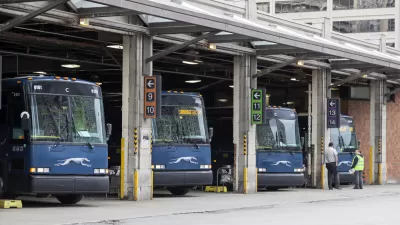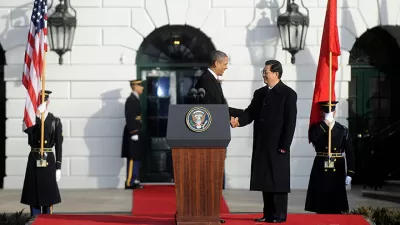On Earth Day the US Department of Transportation released an important new, 605-page report, Transportation's Role in Reducing U.S.
On Earth Day the US Department of Transportation released an important new, 605-page report, Transportation's Role in Reducing U.S. Greenhouse Gas Emissions which provides good news for anybody interested in transport system optimization (also see the Secretary of Transportation's blog).

This study evaluates potential transportation greenhouse gas (GHG) emission reduction strategies, as mandated by the Energy Independence and Security Act. The good news is that it attempts to account for indirect impacts that result from strategies that affect total vehicle travel. Many earlier emission reduction assessments overlooked these impacts, and so tended to favor policies that simply encourage the purchase of more efficient and alternative fuel vehicles, since those seem the easiest way to reduce emissions. However, at best those strategies help achieve two planning objectives: energy conservation and emission reductions. They do nothing to achieve other objectives such as congestion reductions, increased traffic safety, or to improve public fitness and health. In fact, because increased fuel efficiency reduces the per-mile cost of driving, these strategies tend to stimulate more total vehicle travel (called a rebound effect) which exacerbates other transportation problems.
On the other hand, mobility management (also called transportation demand management) strategies provide a much larger range of benefits because they improve transportation options (better walking, cycling, ridesharing and public transit) and give travelers incentives to use the most efficient option for each trip. As a result, they provide the following benefits:
- Congestion reductions
- Road and parking facility cost savings
- Consumer savings and affordability
- Accident reductions
- Improved mobility for non-drivers
- Energy conservation
- Emission reductions
- Reduced sprawl
- Improved public fitness and health
Tables 3.3 to 3.6 of the report provide estimated cost per tonne of carbon dioxide emission equivalent (CO2e), taking into account some indirect impacts. The results indicate that fuel shifting strategies have uncertain net benefits; for example, electric-powered cars have estimated costs ranging from $343 cost to a $90 net savings per tonne of CO2e reduced. Similarly, traffic management (such as improved traffic signal synchronization, and freeway onramp controls) had costs ranging from more than $2,000 cost to $120 net savings per tonne of CO2e reduced.
The really big winners in terms of cost efficiency were (see table below):
- Commute trip reduction programs ($1,000 per tonne net savings)
- Pay-as-you-drive vehicle insurance ($960 per tonne net savings)
- Smart growth land use policies ($700-800 per tonne net savings)
- Non-motorized transportation improvements ($600-700 per tonne net savings)
- Urban center cordon pricing ($530-640 per tonne net savings)
- Comprehensive congestion pricing ($440-570 per tonne net savings)

Table 3.6 shows the cost efficiency of mobility management strategies. Values in parenthesis indicate negative cost (net benefits, that is, benefits exceed costs). Pricing reforms, such as VMT fees and Pay-As-You-Drive insurance, are most cost effective because they provide significant co-benefits such as congestion and accident reductions.
These can be considered Win-Win Emission Reduction Strategies because they provide multiple benefits. They are "no regrets" strategies, because they are justifed for their economic benefits, regardless of the value placed on their emission reductions.
Climate change emission reduction benefits are typically valued at $50 per tonne. Other impacts are much larger in magnitude. This indicates the importance of considering indirect impacts: emission reduction strategies are worth far more if they also help achieve other planning objectives, but worth far less (they often have negative net value) if they stimulate more VMT and so exacerbate problems such as traffic congestion, accidents, road and parking facility costs, and sprawl.
The actual benefits of pricing strategies are probably much larger than the report estimated because their analysis used outdated assumptions. As discussed in the report's Appendix A: Methodological Issues, the analysis used elasticity values based on studies by Hughes, Knittel and Sperling and Small and Van Dender, which found that fuel price elasticities declined significantly between 1975 and 2006, down to -0.057 (a 10% increase in the price of driving reduces vehicle travel only 0.57%. However, those results reflect unique factors that stimulated vehicle travel demand during that time period, including declining real fuel prices, rising female employment, peak Baby Boom driving years, rising real incomes, and sprawl-encouraging highway building and development policies.
More recent studies indicate higher elasticities (a change in vehicle operating costs have a larger impact on vehicle travel), likely due to demographic and economic trends such as aging populations, stagnant real incomes, increased urbanization, improvements to alternative modes, and changing consumer preferences. Komanoff found that the short-run U.S. fuel price elasticity reached a low of -0.04 in 2004, but increased to -0.08 in 2005, -0.12 in 2006 and -0.16 in 2007, and long-run effects are typically about three times short-run, suggesting long-run effects as high as -0.48. Brand found that the 20% U.S. fuel price increase between 2007 and 2008 caused a 4.0% reduction in fuel consumption, indicating a short-run price elasticity of -0.13, and accounting for population and GDP growth, about -0.17. Long-run elasticities are typically two or three times higher, which is -0.3 to -0.5 (a 10% increase in vehicle operating costs reduces driving by 3-5%).
For more information on these factors see our report, Transportation Elasticities, in particular, the sections on "Vehicle Operating (Out-of-Pocket) Expenses" and "Vehicle Travel With Respect to Fuel Price". Most these studies show long-run elasticities of -0.2 to -0.5.
The USDOT study significantly underrates Pay-as-you-drive vehicle insurance (report pages 499-501). It assumes that, at most, 75% of insurance policies representing 43% of VMT would have PAYD pricing, although a total shift to PAYD is justified on traffic safety grounds (it could save about 5,000 lives annual in the U.S.) just as federal government policies have required states to implement seatbelt laws, DWI enforcement standards and motorcycle helmet laws, and it also helps achieve other insurance regulatory objectives. It assumes that PAYD would require a $131 billion cost for mechanical "hubodometers" to record vehicle mileage, but companies that currently offer PAYD insurance, such as Milemeter, simply use odometer readings, which minimizes costs. Modern odometers are extremely reliable - they must be because they are the basis of vehicle warrantee, lease and resale transactions, which often involve far larger financial burdens on vehicle manufacturers and dealers than a typical annual insurance transaction. The report also assumes that the average PAYD fee would be 4¢ to 6¢ cents per mile, although if fully implemented it would be 9¢ mile.
The USDOT study concludes that PAYD could reduce VMT and emissions by up to 3%, but other published studies (my own and those by Bordoff and Pascal, and Edlin) indicate greater travel impacts (typically 8-12% VMT reductions per affected vehicle if insurance is fully marginalized) and benefits. Of course, achieving these maximum benefits is not necessarily easy, but it is quite feasible and cost effective, so I think it is important that decision-makers understand this when evaluating options.
For more information
AASHTO (2009), Real Transportation Solutions for Greenhouse Gas Emissions Reductions, American Association of State Highway Transportation Officials (www.transportation.org); at www.transportation1.org/RealSolutions/index.html.
Cambridge Systematics (2009), Moving Cooler: Transportation Strategies to Reduce Greenhouse Gas Emissions (www.movingcooler.info), co-sponsored by a variety of organizations; report at http://commerce.uli.org/misc/movingcooler.pdf; summary at http://commerce.uli.org/misc/movingcoolerexecsum.pdf.
CCAP (2009), How Much Can We Slow VMT Growth? The Potential Savings of Implementing Best Practice Everywhere, Center for Clean Air Policy (www.ccap.org); at www.ccap.org/docs/resources/460/How%20much%20can%20we%20slow%20VMT%20growth%20May%202008.pdf.
Co-Benefits Asia Hub Website (www.observatory.ph/co-benefits_asia)
Kara M. Kockelman, Matthew Bomberg, Mellisa Thompson and Charlotte Whitehead (2009), GHG Emissions Control Options: Opportunities for Conservation, for the Transportation Research Board Special Report 298, Driving And The Built Environment, TRB (www.trb.org); at http://onlinepubs.trb.org/Onlinepubs/sr/sr298kockelman.pdf; also at www.ce.utexas.edu/prof/kockelman/public_html/NAS_CarbonReductions.pdf.
James Leather (2009), Rethinking Transport and Climate Change, Asian Development Bank (www.adb.org); at www.transport2012.org/bridging/ressources/files/1/96,Rethinking_Transport_and_Climate_Chan.pdf.
Todd Litman (2005), "Efficient Vehicles Versus Efficient Transportation: Comparing Transportation Energy Conservation Strategies," Transport Policy, Volume 12, Issue 2, March 2005, Pages 121-129; at www.vtpi.org/cafe.pdf.
Todd Litman (2008), Smart Transportation Emission Reduction Strategies, Victoria Transport Policy Institute (www.vtpi.org); at www.vtpi.org/ster.pdf.
Todd Litman (2009), Are Vehicle Travel Reduction Targets Justified? Evaluating Mobility Management Policy Objectives Such As Targets To Reduce VMT And Increase Use Of Alternative Modes, Victoria Transport Policy Institute (www.vtpi.org); at www.vtpi.org/vmt_red.pdf.
W. Ross Morrow, Kelly Sims Gallagher, Gustavo Collantes and Henry Lee (2010), Analysis of Policies to Reduce Oil Consumption and Greenhouse-Gas Emissions from the U.S. Transportation Sector, Belfer Center, Kennedy School of Government, Harvard University (http://belfercenter.ksg.harvard.edu); at http://belfercenter.ksg.harvard.edu/files/Policies%20to%20Reduce%20Oil%20Consumption%20and%20Greenhouse%20Gas%20Emissions%20from%20Transportation.pdf.

Maui's Vacation Rental Debate Turns Ugly
Verbal attacks, misinformation campaigns and fistfights plague a high-stakes debate to convert thousands of vacation rentals into long-term housing.

Planetizen Federal Action Tracker
A weekly monitor of how Trump’s orders and actions are impacting planners and planning in America.

In Urban Planning, AI Prompting Could be the New Design Thinking
Creativity has long been key to great urban design. What if we see AI as our new creative partner?

King County Supportive Housing Program Offers Hope for Unhoused Residents
The county is taking a ‘Housing First’ approach that prioritizes getting people into housing, then offering wraparound supportive services.

Researchers Use AI to Get Clearer Picture of US Housing
Analysts are using artificial intelligence to supercharge their research by allowing them to comb through data faster. Though these AI tools can be error prone, they save time and housing researchers are optimistic about the future.

Making Shared Micromobility More Inclusive
Cities and shared mobility system operators can do more to include people with disabilities in planning and operations, per a new report.
Urban Design for Planners 1: Software Tools
This six-course series explores essential urban design concepts using open source software and equips planners with the tools they need to participate fully in the urban design process.
Planning for Universal Design
Learn the tools for implementing Universal Design in planning regulations.
planning NEXT
Appalachian Highlands Housing Partners
Mpact (founded as Rail~Volution)
City of Camden Redevelopment Agency
City of Astoria
City of Portland
City of Laramie






























